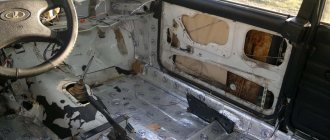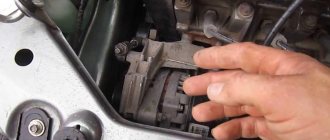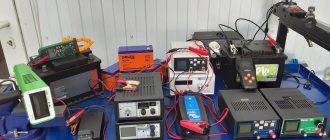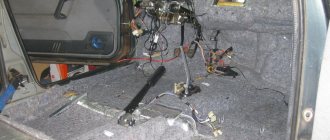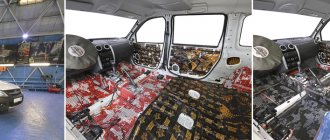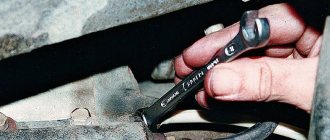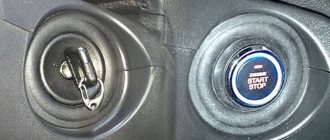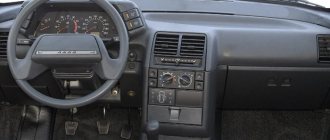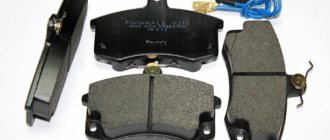Sound insulation of car fender liners is a set of actions aimed at increasing comfort in the cabin by treating the surface with special sound and vibration insulating materials.
When done correctly, it is possible to eliminate the annoying impacts of stones on the wheel arches, as well as the noise of rubber when driving at high speed (especially important in winter, when the wheels have winter tires).
What are the features of such work? Is it possible to do without involving specialists? What materials will be needed? We will discuss these and other points in the article.
When and why to soundproof the fender liner?
Service station technicians and people with experience in similar work are confident that proper sound insulation of fender liners is a guarantee of solving the following problems:
- Reducing noise from stones that fly out from under the wheels and hit the arches.
- Protection from salt and snow that gets into the nooks and crannies of the metal and accelerates the corrosion process.
- Reducing the destructive effect on the body.
- Increased comfort in the cabin by eliminating extraneous sound.
For greater efficiency it is recommended:
- Carry out noise insulation of the fender liner along with the treatment of wheel arches and the bottom with vibration and sound-absorbing material.
- Use high-quality products that can absorb extraneous sounds and vibrations, as well as withstand elevated temperatures.
Ways to soundproof fender liners
Experts highlight the following options for sound insulation of fender liners:
Processing arches from inside the car.
It is believed that this is where the work should begin.
First, the surface is cleaned, treated with special disinfecting compounds, and then glued with Bimast.
For greater effect, the top is pasted with sound-absorbing material (as an option - Accent) or other material.
Thanks to the use of this technique, it is possible to solve the main problem - to reduce the level of noise coming from the wheels into the cabin.
Processing arches from the outside.
This option is most popular among car enthusiasts. The algorithm of actions is as follows. First, the fender liners are dismantled (if they were installed).
Afterwards, the metal is cleaned of the anti-corrosion coating, treated with degreasing compounds and glued with vibration-damping material (one of the options is the use of Bimast Bomb or Shumoff Prof. 8 F).
During the work, attention is paid not only to the metal part of the arch, but also to the fender liners located from the inside (the side that “looks” at the body).
Do subsequent activities as desired. The best option is to glue everything using Splen (Izolon Tape).
Pay special attention to the thickness - it should be maximum (8 mm).
When applying sound insulation to the outside, be aware of the risk of metal corrosion.
To avoid such problems and protect the body part from damage, treat non-glued areas with anti-corrosion agent (an alternative is to use a special mastic).
Please note that the classic soundproofing kit is not suitable for external treatment. If you decide to do such work, then be prepared for the consequences in the form of low efficiency and corrosion.
External sound insulation of arches.
There is another option - processing the arches from the outside. Use special compounds that reduce noise levels (they are similar in structure to mastic), the so-called liquid noise insulation.
The advantage of such means is effective vibration damping and sound insulation.
Materials used
Three types of materials can be distinguished, which are used separately or combined depending on the requirements and capabilities of the machine owner. This:
Types of car sound insulation
- Vibration damper - the main purpose of which is to dampen vibrations in the arched space, which helps reduce its noise. The most popular material in this category is the self-adhesive “Bimast Bomb” on a bitumen base with a metallized surface;
- Sound insulator - which is intended directly to cut off noise arising in the arched space. The most popular here is “Vibroplast”, also a self-adhesive material that can be used in combination with a vibration damper as a second insulating layer;
- Liquid fender liners based on liquid rubber - there are many popular brands of such compounds. Their advantage is the possibility of application to any surface, regardless of their configuration, in particular to the arches themselves without fender liners.
The most common insulator at the moment is “Vibroplast” - an excellent material that does not rot and is practically not destroyed by aging, and also has a good quality-to-cost ratio. To ensure high-quality sizing, you need to strive to minimize the number of joints and achieve maximum adherence of the insulator to the plastic of the fender liner. This is necessary not only to improve sound insulation, but also to prevent water from penetrating inside, which will gradually destroy the glue.
Noise insulation of wheel arches
Is it possible to do this work yourself?
As many car enthusiasts claim, the entire range of activities can be carried out in a garage.
All you need for this:
- Several hours of personal time;
- Knowledge of the technical part. Before starting work, study what, how and where you will glue;
- Availability of necessary materials (purchase in advance). We will consider below what is required to complete the work;
- A certain amount on hand. The level of costs depends on the quality of the selected products. On average, processing four fender liners will require 1500-2000 rubles (the most optimistic forecast).
What you need for do-it-yourself soundproofing
Soundproofing the front and rear arches of a car with your own hands does not involve performing any overly complex work, however, this is a rather labor-intensive process that, with all the effort, will take at least several hours. To work you will need:
- construction hair dryer;
- stationery knife;
- tools for dismantling/installing wheels;
- a can of black paint;
- jack;
- the fenders themselves.
In addition, “Vibroplast” is needed for a car, which is sold immediately in sheets, one for each fender liner.
Preparation for work and order of execution
The first thing to start with is to prepare the equipment and materials for work. Otherwise, you will be distracted by going to the store and end up wasting a lot of time.
If the car does not have plastic fender liners, then the material is applied directly to the metal of the arches.
As for the soundproofing of the fender liner itself, it is carried out using the following products:
Vibration damper.
The master recommends vibroplast, which is applied first. The advantage is a high mechanical loss coefficient and, accordingly, excellent damping properties.
The best option is to use Bimast Bombs KMP, for which the coefficient mentioned above is 0.4 units.
Due to the rigidity of the material, it can be used not only in small areas, but also for soundproofing the entire car. In this case, the brand of the car does not matter.
The advantage of Bimast Bomb lies in its composition. The basis is a bitumen-mastic substance. The surface is metallized on top and covered with an additional layer on the bottom for protection.
During the installation process, provide pre-heating, for which use a hair dryer.
The warming up process is carried out as follows:
- Remove the top layer and lay the product with the sticky part facing up. It is necessary to lay only on a washed, clean, dry metal surface;
- Heat the surface with a hairdryer until it shines. Do not overheat and do not bring to a boil;
- Turn the material over and glue it to the surface to be treated, then use the mounting roller to distribute the heated product.
Soundproofing material.
After the vibration damper comes the turn of Spleen, which can be the second or third layer.
Advantages:
- High efficiency;
- Easy to apply. This is primarily due to the presence of an adhesive layer, which eliminates the need to apply other compounds;
- Affordable price;
- Excellent thermal insulation qualities. Practice has shown that the use of this material guarantees heat retention, which is especially important in winter. If you live in a region with harsh winters, then this feature is only a plus;
- Reliability of fixation. After completion of the work, the material is firmly fixed, and it can only be torn off with great effort.
Due to its ability to repel sound waves, Splen is more suitable for processing the external part of the body.
For gluing the inside, give preference to Accent.
Please note that it is not recommended to glue Spleen as the first layer. The best option is laying the third layer after noise and vibration insulation materials.
When performing work, consider the following points:
- Use the largest sheet sizes to improve efficiency.
- Make sure to keep the number of joints to a minimum (again, to increase efficiency). If you only have small pieces of Spleen on hand, it is better to buy a whole piece.
Liquid sound insulation.
The main mistake of beginners is the use of sheet-type sound insulation. Its disadvantage is insufficient protection from environmental influences, namely:
- Excessive exposure to moisture absorption;
- Destruction under the influence of chemical reagents;
- Reduced service life with frequent changes in temperature.
If you ignore the recommendations and stick sheet material onto the fender liners, then over time it will delaminate and cease to cope with the assigned tasks - it allows extraneous sounds to pass through and does not protect the surface from corrosion.
Liquid sound insulation is more effective in this regard, and therefore is not a bad alternative.
Its advantages:
- Ability to withstand large temperature changes;
- Resistance to the negative effects of solutions containing salt and other reagents (often found on roads in winter);
- Resistance to impacts of a mechanical nature (gravel).
This type of sound insulation is based on liquid rubber, which acquires the required strength immediately after drying.
With proper treatment, the surface of the body is reliably protected from negative influences.
In addition, the composition eliminates noise penetration from the interior and extends the life of the metal without corrosion. The greatest effect is achieved when the material is used in combination.
Sound insulation without “lockers” (fender liners): work order
If the car does not have plastic fender liners installed, then the meaning of external sound insulation comes down to finishing the metal surface of the body.
Proceed like this:
- Clean the arches from dust and dirt. The best option is to use a washing machine that supplies high pressure water.
- Let the metal dry.
- Degrease the surface using nitro solvent.
- Use liquid or classic compositions to impart soundproofing properties. The choice of options is wide. If you don’t have a large sum on hand, give preference to multi-bitumen mastics. If there are no problems with money, then you can take a more expensive composition.
- Before applying the composition, cover the parts that you do not plan to cover with soundproofing material. Use plastic film for these purposes (fix it with tape).
- If you decide to use liquid sound insulation for arches, apply the first layer of mastic and let it dry.
- Treat the surface with a second layer, roll the product and dry.
Please note that the number of coats applied to the body may vary. This information can be easily gleaned from the manufacturer's instructions.
It also reveals the drying features of each applied layer.
Some “craftsmen” recommend making sound insulation in layers, that is, applying mastic, Splen, mastic, and so on (in a circle).
In this case, Splen will quickly peel off, and corrosion will not be long in coming.
Conclusion
Well-made sound insulation of car fender arches effectively protects against noise penetration while driving on crushed stone and on asphalt on hard rubber. Some are limited to installing liquid or plastic fender liners only, some do it only on the outside, some on the inside, and some on both. You decide. If the car is driven a little, for example, only around the city, then at low speeds there is no noise while driving. According to reviews, the Bimast Bomb soundproofing has the greatest effect; I haven’t used it myself.
Sound insulation with plastic fender liners: work procedure
It is believed that the only purpose of plastic fender liners is to protect the arches from dirt or water. But we cannot fail to note one more function - the ability to use the product in the form of a sound shield.
Proceed as follows:
- Remove the wheel arch liners, clean them and treat them with a degreasing compound.
- Perform arch processing in the order described above;
- Apply Vibroplast to the inside of the fender liner. Be careful - some fender liners have holes for ventilation. If this is your case, then it is not recommended to close the holes.
- Use Splen to improve overall work efficiency and ensure that extraneous sounds are reflected from the surface.
The disadvantage of the considered option is that when temperatures fluctuate, Splen can move away from the surface. To avoid this, use another option:
- Attach rubber plates to the inside of the lockers; these can be “Comfort” sound insulators based on foam rubber (alternatively, they can be cut from car mats).
- Fix the product with waterproof glue.
The difficulty of the rubber mat method is that the rubber material is hard and difficult to cut.
In addition, it is important to use the glue correctly - it must have waterproof qualities. Otherwise, the layer will not last long.
The peculiarity of the “Comfort” sound insulator is that it has a fleecy surface, does not rot and is able to soften shocks, while it is self-adhesive.
How to soundproof wheel arches on the interior side
Soundproofing arches from the inside, from the interior side, is more difficult than from the outside, but this is the most effective way. Step by step it looks like this:
- Surface preparation. Remove the fender liners (lockers), anthers and dismantle the bumper to gain free access to the area.
- Cleaning. Wash the surface of the arches and fender liners, clean it of debris and dirt. The smallest particles of dust will prevent the soundproofing material from adhering.
- Degreasing. To increase the adhesion of the base, coat it with a special compound, such as GSR primer. You can also degrease using White Spirit.
- Pasting with vibration damper. For this purpose, you can use “Liplent Mf Vibrolent”, backed with aluminum foil. It effectively dampens vibrations and stops the spread of structural noise.
- Installation of sound insulation. The finishing touch is a layer of “Liplent Pf” or “Liplent Pi” fabric with high sound-absorbing characteristics.
Using “Liplent Pf” they cover the entire accessible surface of the wheel arches
Work on soundproofing wheel arches should be carried out in a dry, well-ventilated area. It is advisable that the temperature and humidity are not extremely high or low.
How to achieve the best result from processing arches from the outside?
To get the maximum effect when performing work, consider the following points:
- If you don’t have lockers, buy them, they provide more effective sound insulation;
- Clean the arches from dirt and anti-corrosion applied at the factory;
- Treat the clean, degreased surface with a noise-absorbing compound (optionally, 2-component Noise Liquidator).
Its advantage is reliable corrosion protection and excellent sound insulation;
- Glue the lockers from the inside of the Bimas Bomb;
- To increase efficiency, use Splen (you can skip this step).
- Place the plastic fender liners in place and secure them using self-tapping screws or to special holes.
The best option is to use stainless steel fasteners.
Is soundproofing car fender arches effective?
Self-applied soundproofing of the wing arches will fly off over time if this soundproofing cake is not protected. That is, you need to re-attach the fender liners on top of this insulation, if not, buy them. Standard fastening of fender liner pistons. Some people don't trust them because the caps may not withstand different vibrations. Additionally, it can be reinforced with galvanized or stainless steel screws. Self-tapping screws can also be dipped in anticorrosive.
Helpful advice: if there are special holes on the fender liners, then there is no need to seal them with noise. At the end of the article there is a video comparing the effect before installing Shumka and after.
